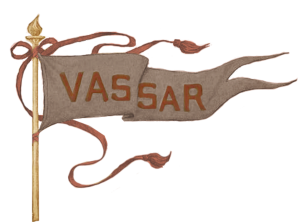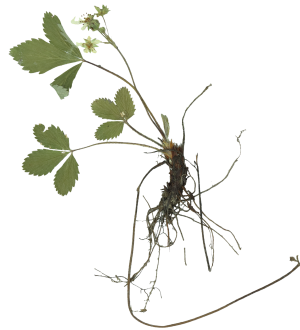1872 - 1963
Edna Carter came to Vassar College as a freshman in 1890. She
retired as professor of physics in 1941. For twenty years after-
ward she kept in touch with members of the faculty and continued
to know many of the graduating seniors in physics. There were thus
seventy years in which she had close contact with the college and
she found it good.
Miss Carter's career in physics spanned the discovery of X-rays,
of the electron, and of radioactivity; the introduction of quantum
theory and its application to atomic structure, of relativity and
of quantum mechanics; the invention of radio and the subsequent
development of radar and lasers; the growth of nuclear physics and
the discovery of many new particles; the discovery of fission and
fusion; Hubble's idea of the expanding universe. She had a gift for
understanding the essense of these new discoveries and ideas, so
that physics courses changed continuously through the decades to
include what was new, so that students at all levels were aware of
the almost explosive opening up of new knowledge and of Miss Carter's
excitement about it. She also always found some way for every in-
coming member of the department to teach what he thought important
in the melee of new physics.
Miss Carter's own research in physics began with a study of the
energy of X-rays in Würzburg, Germany, for which she received her
Ph.D in 1906. From her results the wave length of X-rays could
be deduced, on the assumption that they had a wave nature. The
definitive proof of this assumption came in 1912 with von Laue's
work. In l9ll Miss Carter received the Sarah Berliner Research
Fellowship of the American Association of University Women, then
the largest fellowship offered to women. She returned to Würzburg
to work on vacuum sparks and renewed her friendships with German
physicists. In later years, when her family settled in California,
she carried on her research at the physics laboratory of Mount
Wilson Observatory in Pasadena. There she continued her work on
the spectra of sparks, becoming in the process a spectroscopist
and astronomer. Her work was published in various journals in
Germany and in this country and she was named a Fellow of the
American Physical Society.
Edna Carter was born in High Cliff, Wisconsin, on January 29, 1872
of pioneering parents from New Hampshire. The youngest of nine
children, her playground was the small village on Lake Winnebago,
the countryside, the lake shore, and her father's boat, the Benjamin
Franklin Carter, carrying freight and passengers to Oshkosh, Apple-
ton and Fond du Lac. Her childhood delight in exploring any kind
EDNA CARTER (Continued)
of situation remained throughout her life one of her dominant
characteristics.
As a student at Vassar her first interest was in biology, taught
by Marcella O'Grady who introduced the subject here. In her
junior year she took physics with Mr. Cooley and in her senior
year a newly introduced second course in physics. These were
the courses that indicated the direction her life would take.
After graduation she returned to Wisconsin to attend a state
normal school in Oshkosh, an outstanding school where young
teachers fresh from John Dewey's classroom found themselves
forced to sharpen their wits in discussion with some of the
most renowned teachers in Wisconsin.
The next year she became assistant principal in a nearby high
school. In her own words, "There I taught a great variety of
subjects and sometimes burned the midnight oil literally in a
lamp which smoked badly if I forgot to adjust it. My most vivid
remembrance of that year concerns an argument with a minister.
His sermon in 'Education Week‘ was a shock to all my ideas about
science imbibed from Professor O'Grady's teaching, so I wrote
an article for the local paper. This drew a bitter personal
attack and bad consequences ultimately for my antagonist.
Fortunately for me Dr. Cooley at this point asked me to return
to Vassar as assistant in physics.”
Following two years at Vassar she went to The University of
Chicago where she studied with two great American physicists,
Michelson and Millikan. She then returned to Oshkosh for five
years where she taught in the normal school, an experience she
always recalled as one of the most satisfying of her life, be-
cause of the caliber and strength of purpose of teachers and
students.
In the meantime Marcella O'Grady had married a distinguished
German biologist, Theodor Boveri, in Würzburg. They urged
Miss Carter to join them in Germany to study for her Ph.D. in
physics. This she did in 1904, going by way of England to a
meeting of the British Association for the Advancement of Science
where she met Lord Kelvin, Lord Rayleigh, Sir Oliver Lodge, and
other distinguished physicists. In Wfirzburg she worked in the
laboratory with an international group including Russians, a
Finn, and a Norwegian, as well as several Germans. Here Rbntgen
had discovered X—rays and although he had been called to Munich
she came to know him well. For her work she used the same
EDNA CARTER (Continued)
induction coil with which he had discovered the X-rays. It
was later sent to the Deutches Museum. The director of her
thesis was Wien who, like Rbntgen, was a Nobel prize winner
in physics. She later spoke of these days of the great Germany,
of discussions in the laboratory, weekly colloquia followed by
nachcolloquia and nachnach colloquia which extended far into
the night, walking and skiing expeditions, a trip on a raft
of logs on the river Main, visits to Professors‘ homes. The
talk was always of physics. These were the days of "Akademische
Freiheit," with its implication of privileges of academic
detachment from political involvement, so much cherished by
professors at that time for it left them free to devote them-
selves to their work. They were later to regret their lack
of knowledge of how they were governed. She also spoke of
being the only woman in the laboratory and how naturally the
men accepted her as one of the group.
In her two years in Germany Miss Carter not only laid the
foundation for her own work, but she lived in close contact
with the best minds in physics. When she went to Germany in
l9ll she became friends with the von Laue's. It was at this
time that he found proof of the nature of X-rays and she received
from him as a Christmas card a picture of the X-ray diffraction
pattern which could be explained only by a wave theory. In
later years she exchanged visits here and in German with Wien,
the von Laue's, and others, until their deaths.
In 1906 Miss Carter came to Vassar to stay permanently. Her
work during sumers and leaves of absence in Pasadena from about
1914 yielded rewards for the college beyond the direct enrich-
ment of her teaching. The men with whom she worked and talked,
Hale, Hubble, Babcock, King, and Millikan who had left Chicago
to go to The California Institute of Technology became friends
of the college. Interesting speakers were glad to come here.
Important equipment, otherwise difficult to get, became avail-
able for the laboratory. One example of the latter is the Hale
spectrohelioscope, originally mounted in a shaft built for it
in the Sanders laboratory of physics. In a search for better
seeing it was later moved to the observatory. It has recently
been returned to its original place in the laboratory for use
by students of physics and astronomy.
As a young teacher at Vassar College in the years just after her
return in 1906 Miss Carter opened a world of physics to the
students, and ways of inquiry that were a revelation to them,
and they quoted her to their friends so that her presence was
felt among them far beyond her classroom and was cherished by
them even after they had been graduated fifty years. As chair-
EDNA CARTER (Continued)
man of the department in 1919-1939 she organized its courses,
sought its staff, and designed the functional Henry Sanders
Laboratory of Physics. Her quiet brilliance was recognized
and trusted by her colleagues who persistently through years
elected her to important comittees.
When she first came to live in Lathrop, another specially able
member of the faculty comented to one of her freshmen how
"wonderful to have some one come to live here who is so thought-
ful." In the years when Kendrick was a community, she was a
center of its habitual discussion of principles and goals in
education, the advancement of learning and the state of the
world; of its generous, loyal give and take among friends; of
its fearlessness and delight in sharing its daily tasks. She
was relentless toward any compromising debasement of college
standards, incorruptible in her integrity, but tireless and
generous in helping people who cared about learning, or who had
some need, whether undergraduates, gifted young scholars, col-
leagues, refugees from European tyrranies, or naval officers
turning to teaching. Her clear eyes would twinkle and a luminous
or amused smile would come over her face as she would cut through
pretense or circumlocution and come out with sharply perceived
facts needed in the situation and likely to be glossed over by
less direct and well—centered people. Patiently she would
explain principles of physics to an inquiring colleague at the
breakfast table as well as to her classes, and she would draw
out the best about their interests from a teacher of English,
or Latin, or Theatre, or Geography, assuming the arts and the
sciences to be at home with each other. In her own leisure
she painted with oils and joined other members of the faculty
in Professor Chatterton's special class for them. She had a
way of noticing and remembering their talents.
After her retirement from Vassar she organized a department of
physics at Albertus Magnus College in New Haven, Connecticut,
where she served two years as professor of physics. Following
this she did war work on rockets at The California Institute
of Technology. She finally retired at 73.
We have been glad that she lived among us for years after her
retirement, her mind clear, her belief steady in the greatness
of the college and in the need of it still in educating women
at high levels.
Helen Lockwood
Barbara Swain
Monica Healea, Chairman
XVI 104-106

